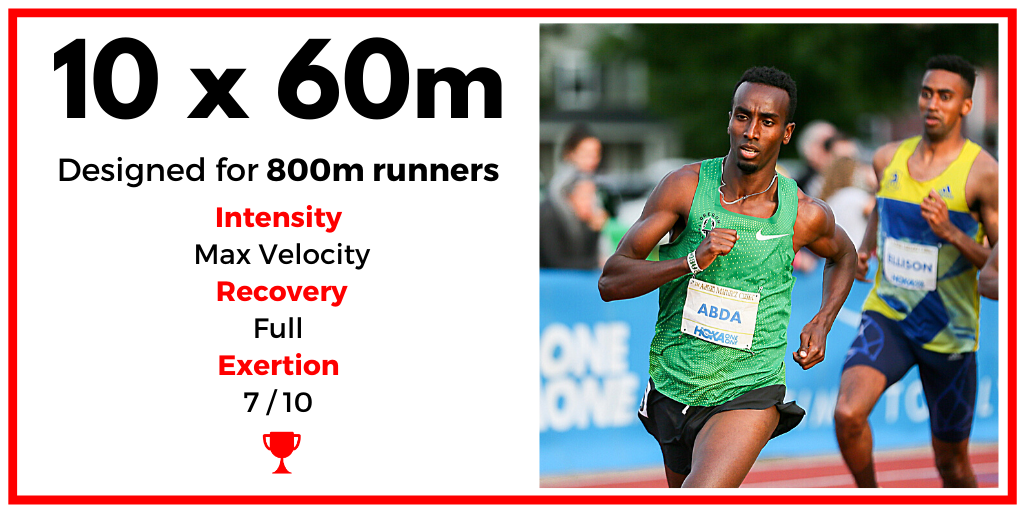Workout of the Day: 10 x 60m
10 x 60m
Intensity — Max Velocity
Recovery — Full Recovery
Exertion — 7/10
Context & Details
When you go back and look through classic American texts on the training of runners you’ll find workout constructions are very simple — and very effective.
This was a standard session for 800m runners in the 1950s, 1960s, and 1970s. Fred Wilt’s books Run Run Run and How They Train are both littered with the employment of this type of session for the 800m runner.
Some may scoff at such a simple workout design, citing there’s not enough volume in the session to stress an energy system. However, long before “energy system development” became a popular training compass coaches and runners were training hard and running fast. The “old-timers” knew what workouts worked even if they didn’t know all the reasons of why it worked that we do today.
10 x 60m sprints with full recovery works because it upgrades neuromuscular power and coordination. Running, like all track and field events, is ultimately a game of physics. It also has a metabolism (or energy system) component, but that doesn’t matter as much as some coaches and runners think. You can develop the biggest engine in the world but if one of your tires is flat or your alignment is way off, the car doesn’t go as fast as it could. Same with running. This relationship between the efficiency of both mechanics and metabolism is why races are not simply a contest of who has the best plumbing.
The longer I coach, the more I appreciate and prioritize the significance of highly coordinated (read: good) running mechanics.
Short sprints work for runners because they are the ultimate skill-specific plyometric. The higher absolute force a runner can express in a short ground contact, the less time they’ll spend on the ground and the longer time they’ll spend in flight projecting forward. To run faster, both stride length and frequency must increase. Regular sprint training does this.
How?
Muscles are tri-phasic. Meaning they have 3 phases of contraction: isometric (no change in length) concentric (shortening), and eccentric (lengthening).
For runners, the fastest and most powerful contraction is not concentric, but eccentric. If the hamstring and glutes are loaded with rapid forces in the eccentric phase of the running gait when the foot strikes the ground that stored energy (called kinetic) is returned back from the ground back to the leg to help project the runner forward. We have our leg’s short-stretch cycle to thank for this. When this happens it’s called reactive running and is governed by the 2nd Law of Physics, not energy system efficacy.
Few western runners run this way, most sprinters (outside of their acceleration phase) as well as elite Kenyan and Ethiopian runners do. It’s perhaps the biggest reason why East Africans dominate distance running, they’re more skilled/coordinated runners. It’s like shooting a jump shot. The most effective technique is not intuitive, feels foreign at first, but is highly efficient and makes the activity significantly easier over the long haul.
If you watch closely, most western runners, even elites, run emphasizing the isometric and concentric muscle contractions. They let their foot “plop” onto the ground, bleeding out all kinetic energy gained in the flight phase, have their leg undergo relatively long isometric contraction with a long ground contact time, and then have to restore to relying on the calf complex to concentrically “push” their body mass forward. Step after step after step.
This method of locomotion requires smaller, ancillary muscles, like those in the calf complex, to do more work than mother nature designed them to do. Calf muscles are designed to help us accelerate and get up to speed, but it’s the glutes and hamstrings which were designed to sustain locomotion once the speed is established.
Show me a runner with overdeveloped quads and calves and I’ll show you a runner who “pushes” every step and because of it is constantly battling lower leg soft tissue and/or bone injuries — shin splints, chronic tight calves, poor ankle mobility, stress fractures in leg bones, etc. are all overuse symptoms associated with this style of unskilled running.
OK, that was a bit of a tangent. Sorry, I could nerd out on running mechanics all day.
Long story short:
All runners should sprint regularly, year-round. Especially runners whose event demands a high power output, like the 800m. Regular sprints will upgrade neuromuscular power and coordination resulting in a faster runner who is capable of running more skilled by generating and sustain higher forces more rapidly per step.

